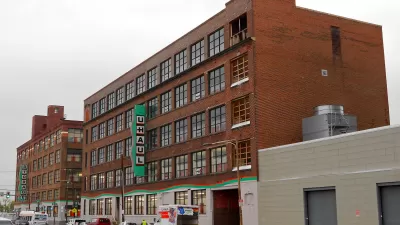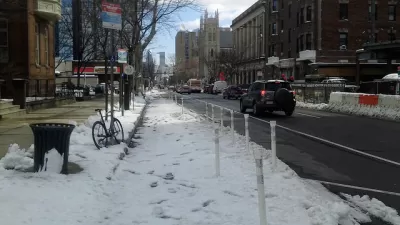Bike advocates have high hopes for the leadership of newly elected Philadelphia Mayor Jim Kenney. Among Mayor Kenney's campaign promises: to add 30 miles of protected bike lanes.
Michael Andersen describes the potential bike infrastructure benefits that could come from the new mayoral administration in Philadelphia. First, however, Andersen provides some context about Philadelphia's well-earned, but perhaps sagging, status as the most bike-friendly large city in the country. According to Andersen, "over the last few years, a second city — Chicago — has been making a dash for Philadelphia's longtime status as the country's bikingest city of more than 1 million." Chicago has achieved gains in bike ridership by "installing one of the country's best-connected networks of buffered and protected bike lanes in its downtown and central neighborhoods."
Now, however, "Philadelphia's new mayor has taken a page from Chicago's book. In the run-up to his landslide victory last May, Jim Kenney pledged [pdf] to build 30 miles of protected bike lanes in the next five years."
All indications so far are that Mayor Kenney intends to follow through on that pledge. One sign of good faith already: earlier this month Mayor Kinney's office announced the creation of the city's new Office of Complete Streets, which comes complete with a "Complete Streets Commissioner." In addition to that support in City Hall, Andersen suggests that local bike advocacy organizations will also lend plenty of help in seeing the goal of 30 miles of protected bike lanes come to fruition. "Last month, the Bicycle Coalition released its own proposal for where to put 30 miles of protected bike lanes around the city," reports Andersen, "most prominently with a JFK/Market couplet through the heart of downtown."
FULL STORY: PHILADELPHIA’S NEW MAYOR PLEDGES 30 MILES OF PROTECTED BIKE LANES IN FIVE YEARS

Study: Maui’s Plan to Convert Vacation Rentals to Long-Term Housing Could Cause Nearly $1 Billion Economic Loss
The plan would reduce visitor accommodation by 25,% resulting in 1,900 jobs lost.

North Texas Transit Leaders Tout Benefits of TOD for Growing Region
At a summit focused on transit-oriented development, policymakers discussed how North Texas’ expanded light rail system can serve as a tool for economic growth.

Using Old Oil and Gas Wells for Green Energy Storage
Penn State researchers have found that repurposing abandoned oil and gas wells for geothermal-assisted compressed-air energy storage can boost efficiency, reduce environmental risks, and support clean energy and job transitions.

Santa Barbara Could Build Housing on County Land
County supervisors moved forward a proposal to build workforce housing on two county-owned parcels.

San Mateo Formally Opposes Freeway Project
The city council will send a letter to Caltrans urging the agency to reconsider a plan to expand the 101 through the city of San Mateo.

A Bronx Community Fights to Have its Voice Heard
After organizing and giving input for decades, the community around the Kingsbridge Armory might actually see it redeveloped — and they want to continue to have a say in how it goes.
Urban Design for Planners 1: Software Tools
This six-course series explores essential urban design concepts using open source software and equips planners with the tools they need to participate fully in the urban design process.
Planning for Universal Design
Learn the tools for implementing Universal Design in planning regulations.
Ascent Environmental
Borough of Carlisle
Institute for Housing and Urban Development Studies (IHS)
City of Grandview
Harvard GSD Executive Education
Toledo-Lucas County Plan Commissions
Salt Lake City
NYU Wagner Graduate School of Public Service





























